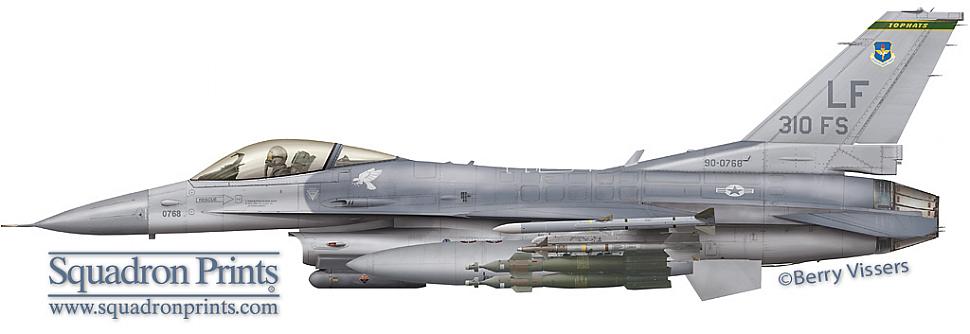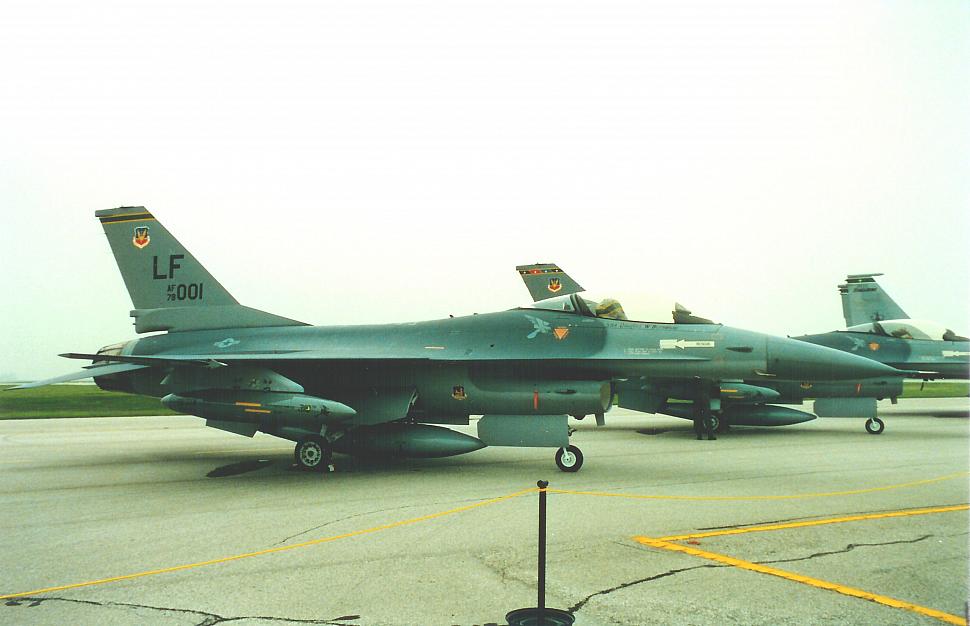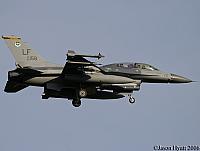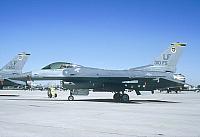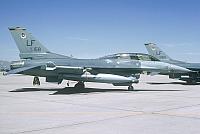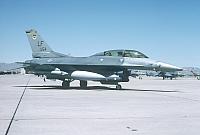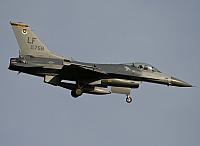 |
310th Fighter Squadron ( USAF AETC)" Tophats" |
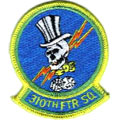 |
310 FS " Tophats" ( USAF AETC) | |||
| Status: |
Converted
|
|||
| Version: | F-16C/D block 42 | |||
| Role: | Training | |||
| Tailband: | Green & Yellow | |||
| Motto: | Dressed to Kill. | |||
| Badge: | N/A | |||
|
Converted to the F-35A in July of 2022.
|
||||
F-16 History
The 310th TFTS along with the 311th TFTS were the first units established with the F-16 at Luke AFB, Arizona in early 1983. First F-16 to arrive at Luke AFB for assignment was F-16B 78-0081 in December of 1982 and would shortly after be assigned the 310th TFTS. Although established in 1983 with the Viper, the squadron started phasing out the F-4 for the F-16 in 1982. Deactivation with the F-4C was on November 4th, 1982. The Squadron would continue the training roll now with the F-16A/B. The 310th FS even had the distinction of operating the first production F-16 #78-0001. During those times at one point Luke AFB operated the first production model of the F-16A/B/C and D.
In the early years of operation with the F-16, the squadron patch was very different an the squadron name was Falcons. Eventually the 310th would return to the patch style used in World War Two with a tophat wearing skull with a pair of dice (see patch top of page). The squadron name changed as well to "Top Hats" which it has carried through to today.
In 1988 the 310th TFTS began receiving brand new block 42s to replace the F-16A/B. The 310th TFTS became the first unit to receive the block 42 and also became the first F-16 squadron to receive the LANTIRN system. Instructor pilots assigned to the 310th developed and wrote the RTU syllabus for both the Block 40/42 and LANTIRN. They also developed the first LANTIRN tactics, since the 422 TES at Nellis had not yet been trained on the aircraft. Until the mid 1990s, the 310th was dedicated almost exclusively to the LANTIRN training mission.
On November 1st, 1991 the 310th was re-designated simply as a Fighter Squadron. Although the word 'Training' was dropped, nothing in that role was changed and was the case for all USAF Tactical Fighter Training Squadrons at that time.
On April 1st, 1994 the 58th FW was renumbered the 56th FW which the Wing number came from the then recently converted MacDill AFB, Florida. Also during the Wing renumbering process, all existing Luke AFB F-16 squadrons were renumbered with the exception being the 310th and 425th FS which were able to keep their history. But as the only remaining original F-16 squadron at Luke, several squadrons have been added over the years making Luke AFB the busiest F-16 base in the entire world.
During the late 1990s with the growing use of night vision goggles the 310th FS has become the principle trainer in this role. It was several years later that the squadron began cranking out night-vision goggle qualified pilots. Although now well known for night vision training, the 310th FS is also tasked with other pilot training normally in the realms of advanced pilot training. One such program is Forward Air Controller, of which the 310th FS is currently the only squadron in the USAF that trains F-16 pilots in this role. Each class lasts five weeks and includes twelve sorties intended to test technical knowledge of the program. The 310th Fighter Squadron on average graduates thirteen classes of FAC qualified pilots a year.
Beginning in April of 2004 the 310th FS was tasked with all night vision goggle training. Pilots going through this training program have to be experienced as the night vision goggles prove to be very challenging. New pilots to the training program have known to follow stars in the sky thinking they are following their flight leader. In bad weather the goggles can be useless as they depend on some source of light. A common training element is to have students fly in a four ship formations on a strike mission having to fight their way in and out against enemy aggressors. In all, a trainee will face three to four weeks of training using the goggles including simulator time and eight sorties in the real jet. Although it fluctuates, the school often turns out 150 night vision goggle trained pilots a year.
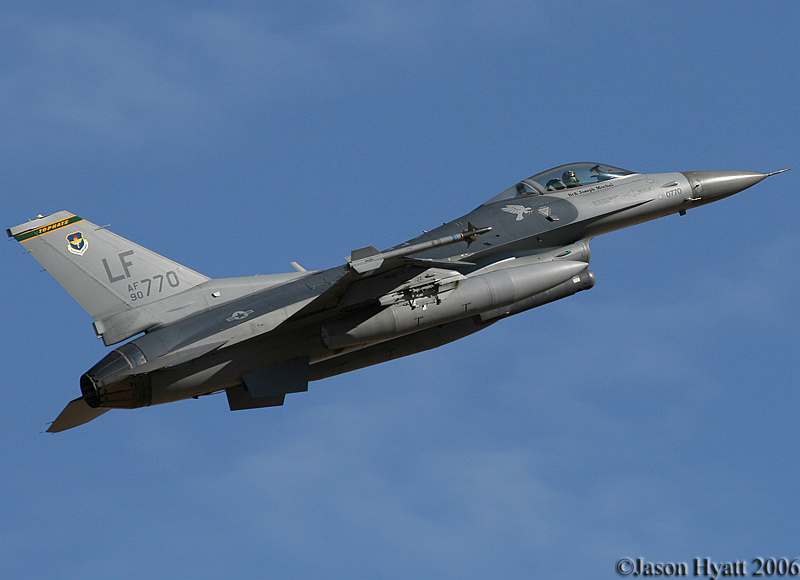
Aircraft Markings History
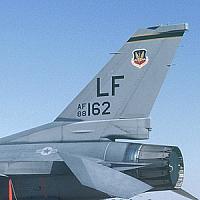
A dark green tailband with a gold/yellow boarder have been the main stay in spite of the wing being renumbered in April of 1994. The 'LF' tail code which adorns all F-16s from Luke AFB has been said to mean Luke Falcons (referring to Fighting Falcon) or 'Luke Fighters'. It most likely means Luke Falcon as the LF tail code was adopted when the F-16s arrived on base. In some cases a gold star was added to the green stripe. The stars were awards for "jet of the month" so not all jets had them. They were stenciled on by the Dedicated Crew Chief. The stars stayed on until the next time the aircraft was sent to be painted. More than one star would be applied if the jet was awarded more than once.
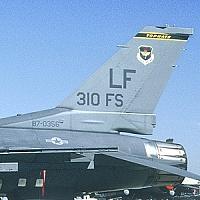
The word "Tophats" was added into the tailband in yellow lettering. The band is surrounded more by a yellow band than gold.
Unit History
- 1942: Activation of the squadron in Harding, Louisiana
- 1942: P-39 'Aircobra' (part of 58 PG)
- 1942: P-40 'Warhawk' (Dale Mabry Field, Florida)
- 1942: P-40 'Warhawk' (Richmond AAB, Virginia)
- 1942: P-40 'Warhawk' (Philadelphia AP, Pennsylvania)
- 1943: P-47 'Thunderbolt' (Bradley Field, Connecticut)
- 1943: P-47 'Thunderbolt' (Hillsgrove Field, Rhode Island)
- 1943: P-47 'Thunderbolt' (Grenier Field, New Hampshire)
- 1943: P-47 'Thunderbolt' (Archerfield AP [Aus.])
- 1943: P-47 'Thunderbolt' (Dobodura Field [N. Guin.])
- 1944: P-47 'Thunderbolt' (Saidor Field [N. Guin.])
- 1944: P-47 'Thunderbolt' (Kornasoren Field [N. Guin.])
- 1944: P-47 'Thunderbolt' (San Roque Field [Phil.])
- 1944: P-47 'Thunderbolt' (McGuire Field [Phil.])
- 1945: P-47 'Thunderbolt' (Mangaldan Field [Phil.])
- 1945: P-47 'Thunderbolt' (Porac Field [Phil.])
- 1945: P-47 'Thunderbolt' (Shima Field [Jap.])
- 1945: Disbanded
- 1952: Activation of the squadron in Taegu (South Korea)
- 1952: F-84G 'Thunderjet' (part of 58 FBG)
- 1954: F-86 'Sabre'
- 1955: F-86 'Sabre' (Osan [S. Kor.])
- 1958: Matador - missile sqn (part of 58 TMG)
- 1962: Disbanded
- 1969: Activation of the squadron in Luke, Arizona
- 1969: A-7D 'Corsair II' (part of 58 TTW)
- 1971: F-4C 'Phantom II'
- 1982: F-16A/B 'Fighting Falcon'
- 1988: F-16C/D 'Fighting Falcon'
- 1994: F-16C/D 'Fighting Falcon' (part of 56 FW)
- 2022: Converted
F-16 Airframe Inventory
- All 310 FS F-16s in our F-16 Aircraft Database (past and current aircraft)
- Current 310 FS F-16s in our F-16 Aircraft Database
Photos
Special Thanks
Eric L. Palmer for his news articles on 310th FS pilot training.
Please use this form to add any list any error or omissions you find in the above text.
Note: your comments will be displayed immediately on this page. If you wish to send a private comment to the webmasters, please use the Contact Us link.

